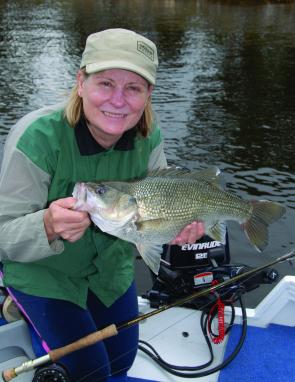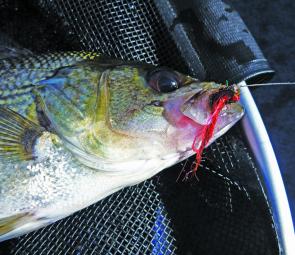Lake Somerset, with its big fat bass, is the place to fly fish this month. The lake and surrounds are postcard perfect, thanks to the ever present rain. Even if the fishing is a bit tough at times, it’s wonderful to be out there on a cool morning with the mist gently moving and the sounder showing big thick lines – bass of course– under the boat.
And unlike some lakes where last summer’s big wet has done the fishing a mischief, Somerset’s bass seem to have stayed put and not gone over the wall. Even back in mid June fish were noted schooling and, on some days at least, were on the chew.
In this article we will take a look at what’s needed to get some solid weight on the fly rod as a bass takes off.
Somerset lake is famous for its big bass, so your tackle will need upgrading. It’s not uncommon to encounter 55-60cm bass, which should be incentive enough to see a 7-8wt outfit in the hand, but if not then the need to get a hooked fish in as quickly as possible should quickly convince you.
I’ve used a 6wt outfit on these fish but it is a slow business when the game commences from 15m down. I believe, from experience, that the longer a hooked fish swims around among his mates in a panicked state the more wary his mates become.
A heavier fly rod matched to a fast sink line – most anglers use the S.A Striped Bass Type IV line for bass work but I’ve also used fast sink fly lines from Snowbee and Rio with success – set up with at least 50m of backing and a rod length twisted leader or store bought fluorocarbon sinking leader (6kg b/s) will form a big part of the tools for the job.
Flies favoured by most Somerset devotees are either large Clousers dressed in silver and white to imitate the main food item of bony bream, or the reliable Vampire patterns either in the traditional black and purple or red and black, which has been a winner in recent years. Hook sizes 6 or 8 are ideal.
A floating fly line isn’t necessary at Somerset Dam as the fish we are targeting will be schooled up quite deeply; surface activity being a non event in this impoundment.
Along with the right fly tackle, a sounder is vital for success. A working knowledge of what your sounder is displaying is essential; be aware that settings that work well in saltwater might need some tweaking in the freshwater environment for best results. I generally reduce sensitivity for freshwater work.
If you are searching for fish in the dam from scratch, without recent visits or red hot info from a mate, then start by moving slowly about and look for signs that identify as fish. If the boat is stationary, the signs are blobs or arches. Sometimes they appear as lines that will materialise into wavy lines or smudges, depending upon the make of the sounder, which are more definite indications of fish.
Once these fish-indicating signs are found, get to a way point set up or drop a marker onto them as a reference. I like the marker option as it’s real, you can see it, and work towards or away from it watching to see where the school ends or has moved.
It’s hard to nominate a hot spot but from what I’ve seen of the lake this year fish are maintaining old habits. The fish are schooling along the edge of the Stanley River bed – 30m below – or along flats adjacent to the river bed. The depth of the lake has particular significance as when the dam was full a few years ago fish schooled in 10-12m of water just south of the old Kirkleigh camping area. Last year I found a few fish in that particular area but plenty straight out to the east of the camping grounds, again not far from the river bed and in 12-15m depth.
Another proven spot is the wide series of flats out from Pelican Point, both north, east and to the south of it. The river bed is a fair way from the flats but the fish will school regularly in these areas. Searching hard and then stopping to try likely showings in all areas will be the key to success. And don’t be afraid to work the fly in up to 15m of water.
A last hint is to watch for gulls or hawks diving on wounded or dying bony bream as this is a definite indicator of bass on the job below.
Last but not least is the method of working a wet fly for these deep holding fish. A long cast should allow a lot of fly line to lay well out from the boat. If the boat’s drifting in the breeze, feed out a bit more line while it’s sinking or maybe give the electric motor a jab to put even more line out in the water.
Next, count down until the fly is very deep (refer to your manufacturer’s sink rates), then strip the fly back in tiny tweaks of around 15-20cm per strip.
Remember to keep up the retrieve right to the boat; fish will feed quite high in the water column and surprise you with an end of rod attack. A ‘bite’ can be nothing more than a tiny pick or a sudden hard wrench depending on whether the fly has been nipped or well taken. In the latter case, it’s game on!
Big bass pull hard and on fly gear will give a great account of themselves.
Reads: 2506
The author’s wife Denise with a decent Somerset Dam bass.

A look at a good showing of bass. Take note of the wide dispersal of fish on the sounder – this is why it pays to keep the retrieve working right to the boat.

Don’t overlook the red Vampire; on some days it’s the best fly for impoundment bass.




